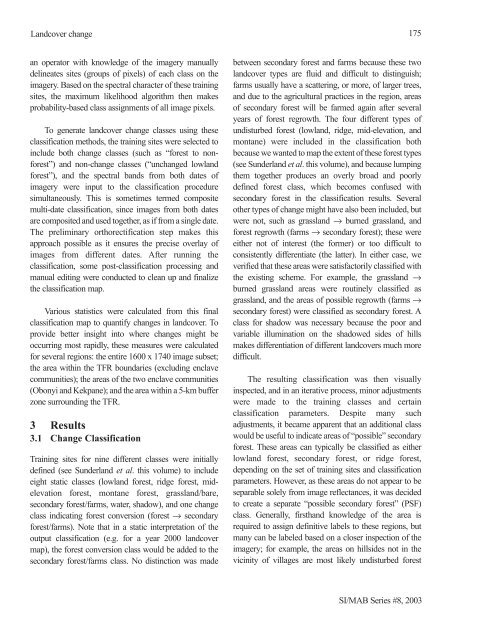Fisheries in the Southern Border Zone of Takamanda - Impact ...
Fisheries in the Southern Border Zone of Takamanda - Impact ...
Fisheries in the Southern Border Zone of Takamanda - Impact ...
You also want an ePaper? Increase the reach of your titles
YUMPU automatically turns print PDFs into web optimized ePapers that Google loves.
Landcover change<br />
an operator with knowledge <strong>of</strong> <strong>the</strong> imagery manually<br />
del<strong>in</strong>eates sites (groups <strong>of</strong> pixels) <strong>of</strong> each class on <strong>the</strong><br />
imagery. Based on <strong>the</strong> spectral character <strong>of</strong> <strong>the</strong>se tra<strong>in</strong><strong>in</strong>g<br />
sites, <strong>the</strong> maximum likelihood algorithm <strong>the</strong>n makes<br />
probability-based class assignments <strong>of</strong> all image pixels.<br />
To generate landcover change classes us<strong>in</strong>g <strong>the</strong>se<br />
classification methods, <strong>the</strong> tra<strong>in</strong><strong>in</strong>g sites were selected to<br />
<strong>in</strong>clude both change classes (such as “forest to nonforest”)<br />
and non-change classes (“unchanged lowland<br />
forest”), and <strong>the</strong> spectral bands from both dates <strong>of</strong><br />
imagery were <strong>in</strong>put to <strong>the</strong> classification procedure<br />
simultaneously. This is sometimes termed composite<br />
multi-date classification, s<strong>in</strong>ce images from both dates<br />
are composited and used toge<strong>the</strong>r, as if from a s<strong>in</strong>gle date.<br />
The prelim<strong>in</strong>ary orthorectification step makes this<br />
approach possible as it ensures <strong>the</strong> precise overlay <strong>of</strong><br />
images from different dates. After runn<strong>in</strong>g <strong>the</strong><br />
classification, some post-classification process<strong>in</strong>g and<br />
manual edit<strong>in</strong>g were conducted to clean up and f<strong>in</strong>alize<br />
<strong>the</strong> classification map.<br />
Various statistics were calculated from this f<strong>in</strong>al<br />
classification map to quantify changes <strong>in</strong> landcover. To<br />
provide better <strong>in</strong>sight <strong>in</strong>to where changes might be<br />
occurr<strong>in</strong>g most rapidly, <strong>the</strong>se measures were calculated<br />
for several regions: <strong>the</strong> entire 1600 x 1740 image subset;<br />
<strong>the</strong> area with<strong>in</strong> <strong>the</strong> TFR boundaries (exclud<strong>in</strong>g enclave<br />
communities); <strong>the</strong> areas <strong>of</strong> <strong>the</strong> two enclave communities<br />
(Obonyi and Kekpane); and <strong>the</strong> area with<strong>in</strong> a 5-km buffer<br />
zone surround<strong>in</strong>g <strong>the</strong> TFR.<br />
3 Results<br />
3.1 Change Classification<br />
Tra<strong>in</strong><strong>in</strong>g sites for n<strong>in</strong>e different classes were <strong>in</strong>itially<br />
def<strong>in</strong>ed (see Sunderland et al. this volume) to <strong>in</strong>clude<br />
eight static classes (lowland forest, ridge forest, midelevation<br />
forest, montane forest, grassland/bare,<br />
secondary forest/farms, water, shadow), and one change<br />
class <strong>in</strong>dicat<strong>in</strong>g forest conversion (forest → secondary<br />
forest/farms). Note that <strong>in</strong> a static <strong>in</strong>terpretation <strong>of</strong> <strong>the</strong><br />
output classification (e.g. for a year 2000 landcover<br />
map), <strong>the</strong> forest conversion class would be added to <strong>the</strong><br />
secondary forest/farms class. No dist<strong>in</strong>ction was made<br />
175<br />
between secondary forest and farms because <strong>the</strong>se two<br />
landcover types are fluid and difficult to dist<strong>in</strong>guish;<br />
farms usually have a scatter<strong>in</strong>g, or more, <strong>of</strong> larger trees,<br />
and due to <strong>the</strong> agricultural practices <strong>in</strong> <strong>the</strong> region, areas<br />
<strong>of</strong> secondary forest will be farmed aga<strong>in</strong> after several<br />
years <strong>of</strong> forest regrowth. The four different types <strong>of</strong><br />
undisturbed forest (lowland, ridge, mid-elevation, and<br />
montane) were <strong>in</strong>cluded <strong>in</strong> <strong>the</strong> classification both<br />
because we wanted to map <strong>the</strong> extent <strong>of</strong> <strong>the</strong>se forest types<br />
(see Sunderland et al. this volume), and because lump<strong>in</strong>g<br />
<strong>the</strong>m toge<strong>the</strong>r produces an overly broad and poorly<br />
def<strong>in</strong>ed forest class, which becomes confused with<br />
secondary forest <strong>in</strong> <strong>the</strong> classification results. Several<br />
o<strong>the</strong>r types <strong>of</strong> change might have also been <strong>in</strong>cluded, but<br />
were not, such as grassland → burned grassland, and<br />
forest regrowth (farms → secondary forest); <strong>the</strong>se were<br />
ei<strong>the</strong>r not <strong>of</strong> <strong>in</strong>terest (<strong>the</strong> former) or too difficult to<br />
consistently differentiate (<strong>the</strong> latter). In ei<strong>the</strong>r case, we<br />
verified that <strong>the</strong>se areas were satisfactorily classified with<br />
<strong>the</strong> exist<strong>in</strong>g scheme. For example, <strong>the</strong> grassland →<br />
burned grassland areas were rout<strong>in</strong>ely classified as<br />
grassland, and <strong>the</strong> areas <strong>of</strong> possible regrowth (farms →<br />
secondary forest) were classified as secondary forest. A<br />
class for shadow was necessary because <strong>the</strong> poor and<br />
variable illum<strong>in</strong>ation on <strong>the</strong> shadowed sides <strong>of</strong> hills<br />
makes differentiation <strong>of</strong> different landcovers much more<br />
difficult.<br />
The result<strong>in</strong>g classification was <strong>the</strong>n visually<br />
<strong>in</strong>spected, and <strong>in</strong> an iterative process, m<strong>in</strong>or adjustments<br />
were made to <strong>the</strong> tra<strong>in</strong><strong>in</strong>g classes and certa<strong>in</strong><br />
classification parameters. Despite many such<br />
adjustments, it became apparent that an additional class<br />
would be useful to <strong>in</strong>dicate areas <strong>of</strong> “possible” secondary<br />
forest. These areas can typically be classified as ei<strong>the</strong>r<br />
lowland forest, secondary forest, or ridge forest,<br />
depend<strong>in</strong>g on <strong>the</strong> set <strong>of</strong> tra<strong>in</strong><strong>in</strong>g sites and classification<br />
parameters. However, as <strong>the</strong>se areas do not appear to be<br />
separable solely from image reflectances, it was decided<br />
to create a separate “possible secondary forest” (PSF)<br />
class. Generally, firsthand knowledge <strong>of</strong> <strong>the</strong> area is<br />
required to assign def<strong>in</strong>itive labels to <strong>the</strong>se regions, but<br />
many can be labeled based on a closer <strong>in</strong>spection <strong>of</strong> <strong>the</strong><br />
imagery; for example, <strong>the</strong> areas on hillsides not <strong>in</strong> <strong>the</strong><br />
vic<strong>in</strong>ity <strong>of</strong> villages are most likely undisturbed forest<br />
SI/MAB Series #8, 2003

















